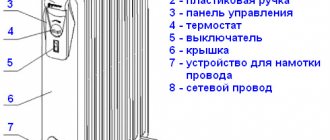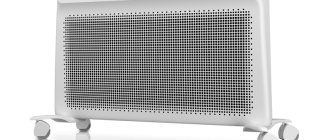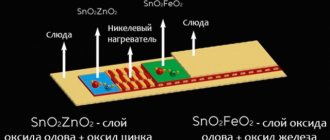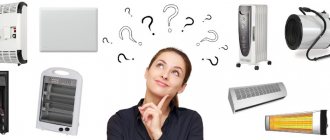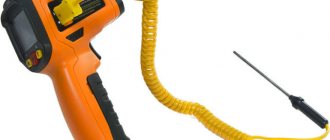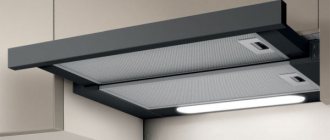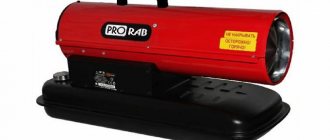There are a large number of types of heaters that allow you to heat a room. Most of the devices run on electricity. Halogen heaters, which are capable of emitting infrared radiation invisible to the eye, are very popular among property owners. The surface of objects gradually heats up. A halogen heater differs from other types of heaters in its high efficiency, safety, small size and lack of noise during operation.
The halogen device cuts off the flow of cold air thanks to its convective ability
Halogen heater device
The design of halogen heaters is based on halogen lamps. The quantity used in the production process allows us to obtain devices of varying power.
The manufacturer installs a reflector element in the body part, which allows the direction of the heat flow to be formed. Halogen lamps are covered with a mesh to prevent burns.
The heating device must be connected to the electrical network. The manufacturer equips the device with various power modes; they can be adjusted using the regulator located on the heater panel.
Operating principle of a halogen heater
Halogen lamps act as a heating element. They are tubular flasks, the length of which is in the range of 20-50 cm. Inside, each shell is filled with a buffer gas, which prevents the spiral from burning out during heating from electric current.
Halogen equipment differs from other heating devices in that it heats up quickly. In just 100-120 seconds, tungsten atoms begin to break away from the spiral and settle on it. This causes intense heating. A lamp connected to the network emits light and infrared wave streams. The heat flow is directed not to heat the air, but to heat the objects located in the room. The room begins to heat up from objects from which heat emanates.
It is worth considering that prolonged use of a halogen device causes the air to dry out. This is why experts recommend turning on a humidifier in the room.
Important! The light weight of the heater allows you to easily move it from one room to another.
The ceiling version of the halogen device is preferably used in rooms with high ceilings
Operating principle of a halogen home heater
The structural basis of the heating device is a halogen lamp. Depending on the heating power, one or more lamps are placed in the product. The body is equipped with a reflector, which ensures the flow of heat into the room. For fire safety purposes, halogen lamps are covered with a mesh.
The device operates from an electrical circuit. Models include different power levels, adjustable by switches. The heater body is made in a modern style and can fit into any apartment interior.
The operating principle is to heat the halogen lamps and dissipate the heat.
The direct source function is performed by the lamp itself. Thermal energy is aimed at heating objects, not air, from which heat emanates and warms up the room.
Heat distribution diagram from a halogen heater Attention! The device interacts directly with air, so long-term use can dry out the air.
Experts recommend additionally using a humidifier indoors.
It takes 5 minutes to heat up. As the lamp heats up, tungsten atoms break away from the filament and settle, which increases heating. The compact halogen device is easy to carry from place to place.
Types of halogen heaters
Manufacturers produce halogen heating devices in several varieties. Below is information to help you become familiar with each type of device.
Halogen devices may differ in purpose:
- household type, the power of which does not exceed 3 kW;
- industrial type, the power of which is more than 3 kW.
According to their design, halogen heaters can be of three types:
- Floor-mounted – a common variety, which is equipped with wheels that allow you to easily transport the device.
- Wall-mounted heaters are designed for heating small areas. It is recommended to install devices at a distance of 140-150 cm from the floor surface. It is important to ensure good thermal insulation of the base, which is made of heat-resistant material.
- Ceiling. The heater is installed using brackets to the base of the ceiling. It is important to equip the base with heat-resistant thermal insulation. Ceiling heaters are installed in rooms where the ceiling height exceeds 3 m.
Advantages and disadvantages of halogen heaters
Like all heating devices, halogen ones also have their disadvantages and advantages. When choosing a halogen heater, the pros and cons are the criteria that make it possible to better understand the basic properties and choose, in comparison with others, the required type of heater.
Advantages
- Heats up very quickly. A couple of minutes is enough to feel the heating effect.
- Quiet, does not produce sounds during operation. An exception may be models with a built-in fan.
- Uniform heating method.
- Due to the operating principle, this type of heater can be used outdoors.
- Absolutely affordable. Adequate price-quality ratio.
Flaws
- It is not recommended to be exposed to short-wave radiation for a long time. This negatively affects the condition of the body.
- Produces bright light. For some this is not a minus, but perhaps on the contrary. However, please note that the lamps emit bright yellow light. This may be disturbing at night.
After analyzing the characteristic properties, you can clearly determine whether this type of heater suits your requirements.
See also -
Are infrared heaters harmful to health or not?
Pros and cons of a halogen heater
Among the main advantages of halogen appliances, it is worth highlighting:
- fire safety, which makes it possible to install them in wooden houses;
- rapid heating of the room (radiation heats not only objects in the room, but also animals and humans);
- no noise during operation;
- durability, service life can exceed 20 years;
- high efficiency of the device;
- temperature control and the ability to set the heater shutdown time;
- no release of hazardous substances during operation of the device;
- The emitter helps destroy viruses that are dangerous to humans.
The disadvantages of a halogen heater include:
- rapid decrease in room temperature after the device is turned off;
- overdrying of hard surfaces;
- the need to use humidifiers;
- negative impact on paint and varnish coatings and furniture fabrics.
It is recommended to place a wall-mounted heating device at a distance of 100-150 cm from the surface of the floor and ceiling
Advantages and disadvantages
Such heaters have their pros and cons. Let's start with the pros:
- Energy Saving – A halogen heater provides heat almost instantly, and the radiant heat it produces effectively heats a small area, significantly reducing the amount of energy consumed.
- Environmentally friendly - do not emit smoke.
- Safety - halogen lamps themselves do not heat up, so they are considered safe.
- Easy Installation – Halogen heaters are easier to install than many alternative heating methods.
Cons: Not ideal for heating rooms – While halogen heaters provide radiant heat, they are not always suitable for heating large areas.
Heater requirements
When choosing an electric halogen heater in a retail chain, it is recommended to pay attention to:
- device power - for every 10 sq. m of area requires 1.3 kW;
- reliability of installation (depending on the condition of the walls and ceilings, you should select the ideal type of installation);
- safety (the presence of a ceramic or basalt insulator and a grounding device will avoid electrical injuries);
- the presence of an overheat protection sensor can prevent the device from igniting;
- high quality heating equipment.
Features of operation
Ceiling models are easy to maintain and only need to be kept clean. It is recommended to install a floor or wall device at a distance of 120-150 cm from the surface of the floor and other objects. Do not allow things to be placed on the heater, which will prevent fire. Covering the heating device with a curtain or tulle is also prohibited. It is better not to touch the functioning device with your hands, so as not to get a thermal burn to the skin. Every 5-7 days, you should clean the halogen device from dust.
Important! Halogen home heaters are capable of emitting short light waves that have a negative effect on the human body. That is why it is not recommended to use the device for an extended period of time.
Safety regulations
Ceiling models of halogen heaters are the safest, since they are inaccessible to mechanical damage and are located at a considerable distance from children and animals. Ceiling versions of heaters only require systematic cleaning of dust. Below is information regarding the rules for the safe use of wall-mounted and floor-mounted halogen appliances:
- Heaters should be located at a distance of 120-150 cm from the surface of the floor and ceiling. Objects can be placed no closer than 100 cm from the device.
- Do not cover the device.
- You cannot use the device to heat a room for a long period of time; this will make it possible to minimize the risk of negative effects of radiation on the human body.
- The lamps of a halogen device must have a special coating, which helps to weaken their glow when heated.
The halogen device can even be placed on an open veranda, because the heat is directed exclusively to objects and people
Pros of a halogen heater
It's amazing how many positive qualities this device has.
- Thanks to a special operating process, heating occurs instantly. It takes a few minutes, after which you will already feel the difference in degrees.
- As for the heating itself, it is uniformity. Some heaters are only capable of producing heat to the bottom of the room. Here the warm air mass is distributed equally over the entire area.
- Availability for purchase. One of the reasons for the high demand is the low cost, justified by the quality.
- It makes no sounds at all during operation. Noise-free guarantee.
- Light weight and compact. This means that you can place or hang the unit in any place, and it, in turn, will not take up much space in the apartment.
- Does not collect dust and therefore does not accumulate dirt.
- It is possible to use it not only in a closed area, but also in open areas.
- Easy to assemble and install.
- It does not dry out the air, so after work it will be easy to breathe and stay indoors.
Which heater is better: quartz or halogen
A wide range of heaters makes you wonder how a quartz heater differs from a halogen heater, and which option should be preferred. The maximum power of a quartz heating device allows you to heat a room whose area is within 10-15 square meters. m, depending on how well the room is insulated. Monoliths are used primarily as an auxiliary heating device, either to maintain heat in a garage or on a veranda. The quartz heater heats up to maximum temperature for 18-22 minutes. Cools for about 40 minutes. The cost-effectiveness of a quartz device is a significant advantage.
Halogen devices, in turn, heat up quickly. In just 100-120 seconds the device reaches its maximum temperature. The atoms of the tungsten filament, having come off the helix, begin to settle on it again, which causes such rapid heating.
Both quartz and halogen heaters cope quite effectively with the task of maintaining heat in the room during the winter. It is difficult to say which one is better, since the first is more economical, and the second allows you to heat your living space in a short period of time.
Which heater is better: halogen or quartz
To choose which heating device is better, you need to consider the main characteristics. The principle of operation of the quartz version is to heat a heat-conducting spiral made of nichrome (an alloy of nickel and chromium). A reinforcing mesh and a spiral are soldered into a monolithic slab measuring 64*34*2.5 cm. Nichrome does not directly interact with air, so it does not burn it. It also does not oxidize, which extends the life of the device.
The design of the quartz device can fit into any interior of the room
The power of the device is 400 W, this heats the monolithic surface to 95 0C. The built-in thermostat allows you to reduce the heating temperature. You can safely dry things on the surface of the heater. This will not cause a fire.
The surface of a monolithic slab varies in color and texture depending on the model. This helps to select the device for the room as accurately as possible in the color schemes of its interior.
The power of the stove allows you to heat a room with a volume of 10-18 m3. To heat a room of 15 m2, you will need 3 such devices. Therefore, quartz heaters are used as an additional source of heating.
Warming up occurs in 20 minutes, cooling in 40-60 minutes. Long-term heat transfer allows the device to be classified as economical.
Halogen heaters are equipped with lamps. The quartz flask contains an inert gas in an amount harmless to humans. The vacuum in it is destructive to metal, so the walls are made of glass.
Halogen heaters heat the room very quickly and evenly
Tungsten ions located on the spiral leave the spiral when heated, and when exposed to an inert gas they return back without settling on the walls of the flask. The halogen device heats up in 2-5 minutes. This type of heating device is classified as auxiliary. Experts do not recommend its long-term use.
DIY halogen lamp heater
If you wish, you can make a heater from halogen lamps with your own hands. To do this, you will need to prepare a suitable container, the dimensions of which are within 40*60 cm (for example, a paint can). The container is cleaned and dried. A brick and a halogen lamp are installed inside the jar, which heats up to 40-50 degrees when emitting light. The wires coming from the lamp are led out. The structure is covered on top with a metal box in which there is no bottom.
Important! The jar with a halogen lamp must be installed on legs, which will make it possible to prevent overheating of the floor surface.
Halogen heaters are safe, so they can be used even in wooden houses
Cons of a halogen heater
Of course, every heating system has disadvantages. This one is no exception.
- Since the increase in temperature also occurs due to the heating of people, there is the possibility of harmful effects.
ATTENTION!
The harmful effects have not been conclusively proven by scientific researchers, however, you should be concerned and definitely not stay under the emitted rays of the device for a long time.
- The operation of the device may be interfered with at night. This is due to radiation in yellow shades. In addition, some owners may be bothered by the bright glow.
- Heating occurs using a local method. The warm air space does not spread throughout all the rooms in the house.
- It is not intended to regulate the degree of heat flow.
- Acceptability of skin burns in humans. If safety precautions are not followed—staying at a certain distance from the unit—you may experience damage to the retina.



